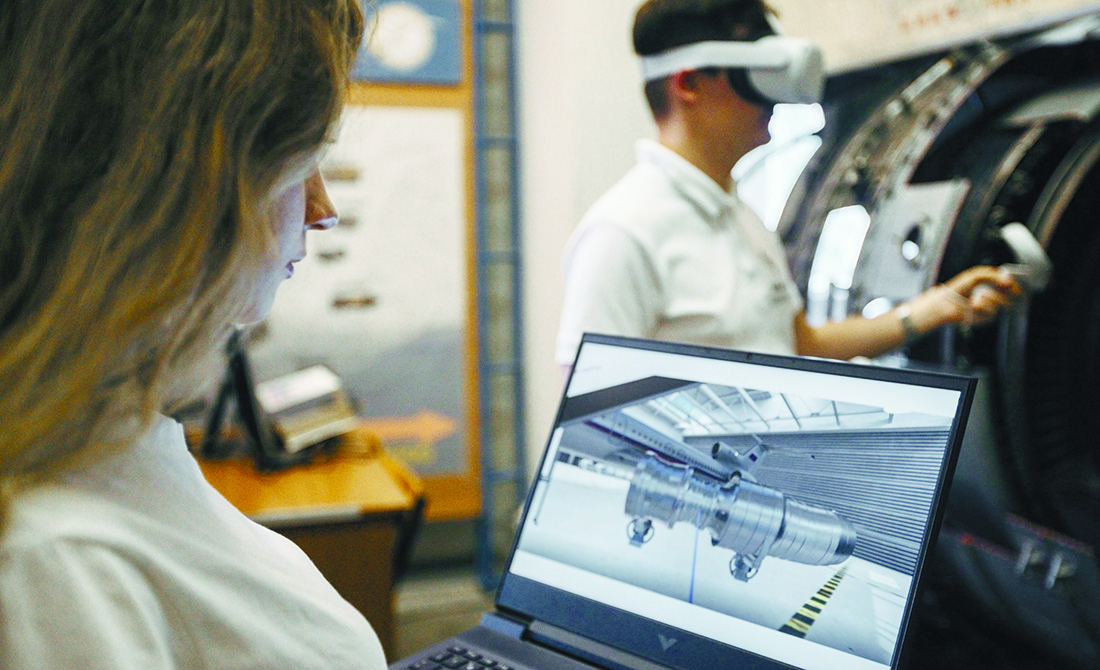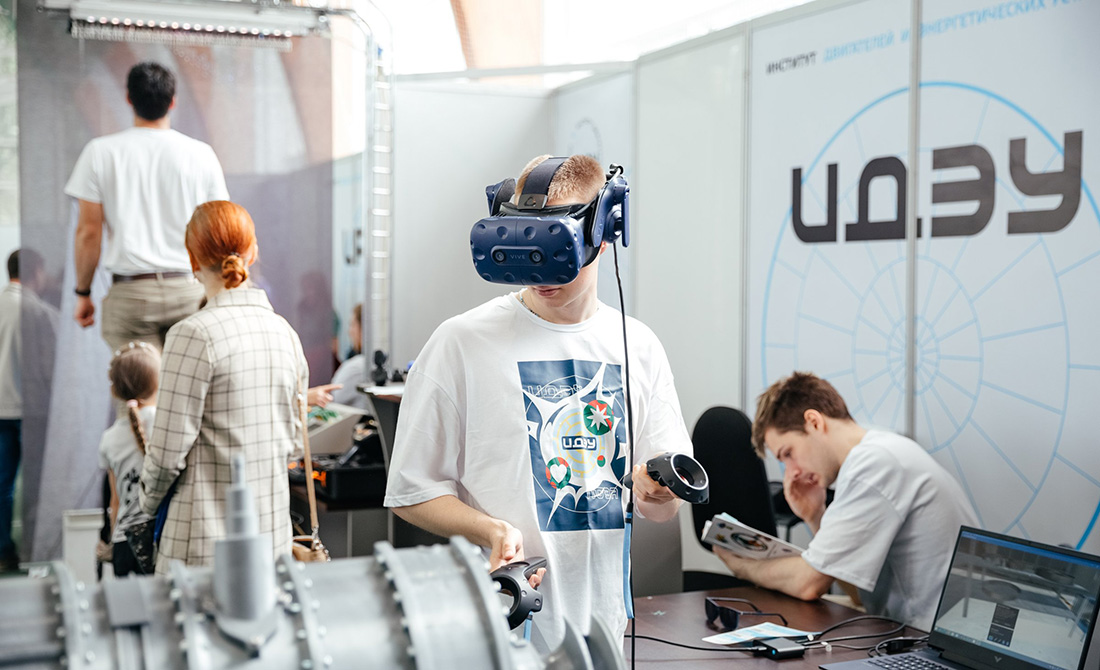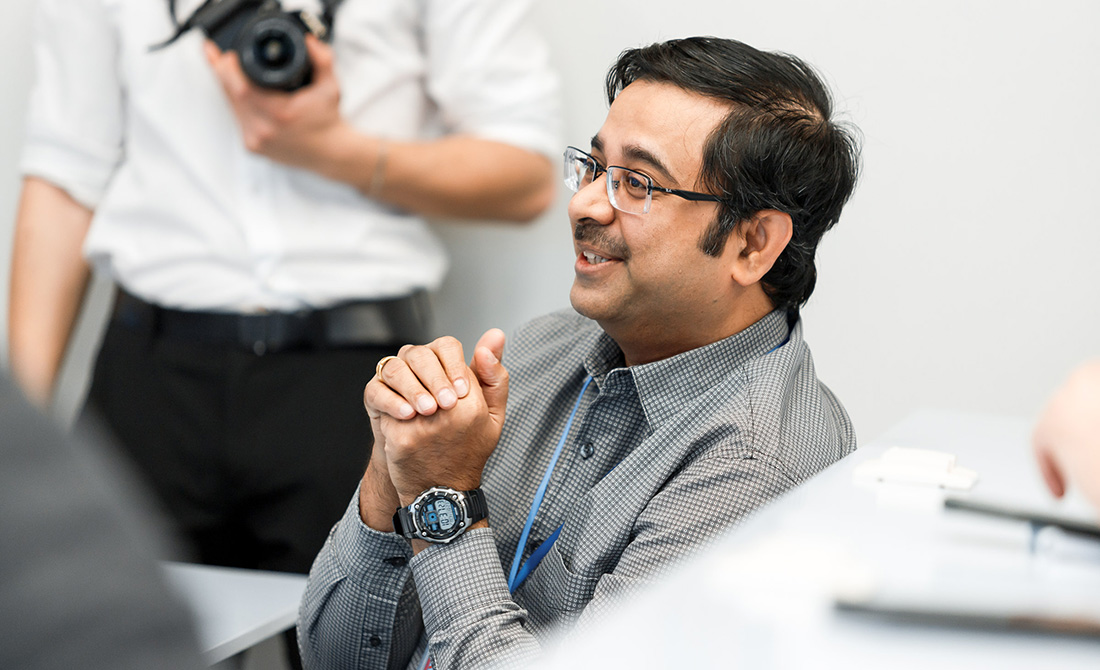In Cooperation with Partners
The University is changing. In accordance with the Priority 2030 Program we keep building and designing a new university which is to become a driver of the social and economic development for the region and to provide staff and innovations for enterprises and organizations of our region, as well as those of the entire country. This year has starkly demonstrated that a whole industrial production can be housed within the buildings of our University. Thus, over 800 unmanned aerial vehicles have been assembled on the basis of the Centre for Unmanned Systems only this year. In the framework of the Advanced Engineering Schools Federal Project two cyberphysical factories are to be created in the University to design and manufacture pilot and experimental batches of small-sized gas-turbine engines and CubeSat nanosatellites along with a digital factory for aviation products to be developed.
The Advanced Engineering Schools Project is aimed at developing cooperation with industrial partners. Under the direction of mentors from enterprises students work on relevant projects that need to be implemented by enterprises right now. Our partners are involved in front-line creation of educational programs. We arrange strategic sessions to understand what competencies are the most important and relevant these days, so that we could change our educational tracks in accordance with new requests. It has become possible due to an opportunity to choose modules in certain subjects and due to individual educational trajectories.
Organizations and enterprises’ need for our scientific developments grows annually. The total sum of all the grants and orders from partners could get closer to a billion rubles over a year. That is the actual profit from academic pursuits of our scientists and the work of R&D laboratories. I think, next year we will outstep the mark of one billion rubles.
Let me name a couple of projects that are important and significant for the entire country. Firstly, upon the order of the Progress Space Rocket Centre our scientists have designed and made the equipment for the future BION-M orbital laboratory No. 2 which is expected to be launched in 2024. The flight of this space laboratory is supposed not to hold a lot of important scientific experiments only, but also to give a comprehensive assessment to the safety of work at the future Russian orbital station which is planned to be located on the same orbit as BION-M No. 2.
Secondly, in the framework of the project on establishment of a high-tech site for industrial gas-turbine engine manufacturing, our scientists have designed an integrated technology for additive manufacturing of parts and blocks of added performance engine hot sections and handed it over for introduction at sites. In the course of the project an intelligent follow-up system of design-engineering preparation of manufacturing has been designed. This system makes it possible to reduce the manufacturing preparation time by more than two times, while reducing labor intensity and production expenses by 30–40 %.
Also, this year we have made significant progress in establishing an experimental legal regime for unmanned aerial vehicles and in developing a safety ecosystem for the entire industry of unmanned aviation. The agreements have been concluded with new partners — Transport of the Future, Avtokom, Delta Tech. Also, the agreement with Aviacor Aviation Plant JSC has been signed. We develop new materials, engines, software, useful load and teach neural network to process images received from the drones’ cameras. We will make pilot batches of unmanned aerial vehicles and other equipment and hand over the technologies for mass production which is currently launched in Togliatti.
The unmanned aerial vehicles will also ensure development of the project on creating the country’s first agrarian carbon polygon (the project has been successfully defended by the University in November). It is created as part of the activities of the world-class Engineering of the Future REC together with Samara State Agrarian University, the Samara State Medical University, the Institute of Ecology and Evolution of RAS. The industrial partners are the Orlovka AIC experimental farm, the UralChem United Chemical Company, as well as Schelkovo Agrochim.
Our scientists will have to develop a mathematical model intended for estimating the dynamics of greenhouse gas emissions in the settings of the Privolzhsky Federal District and to adapt it for Russian agricultural soils. To that end, remote methods of emissions and greenhouse gas runoff monitoring need to be worked out. That is exactly where we use our mobile laboratories — the drones equipped with gas microchromatographers and hyperspectrometers.
Lighthouse Projects
Proactive developments of the University’s scientists include the project on establishment of a platform for the AIST-ST radar-location spacecraft of a new generation. It is designed together with Special Technology Center (STC), a company from Saint Petersburg. The device is designed in the form of a 12U CubeSat. The scientists of the Samara University are creating the space platform itself and a set of scientific gear; STC makes radar surveillance equipment and a propulsion plant. The development is so unique, because the device will be able to perform X-range monitoring of the surface of the Earth. The first demo satellite of this kind is expected to be launched to the orbit in 2024, and in 2025, a large-scale manufacturing is supposed to start at the premises of the University. In the long run, a group of AIST-ST satellites of 600 devices is planned to be created.
Another promising project of the University is development of a small-sized gas turbine power plant with a capacity of 75 kW as part of phasing out imported analogues. As per estimations, the Russian market will need about 2,000 power plants of this kind until 2030. They can be used at power-generating facilities of remote settlements, at gas transmission stations, industrial enterprises, tourist spots, in hospitals, etc. As of now, designing has been completed; a mockup of the power plants has been created along with certain blocks and components. In the framework of expert and analytical follow-up of this project by Rospatent, the expert assessment of technical, legal, financial, market and organizational risks developers need to overcome has been taken. In 2024, it is planned to make a developmental prototype of the power plant and testing benches. Manufacturing at the site of the University is expected to be launched in 2026.
The University also has a great potential in terms of aerial vehicles manufacturing, including unmanned ones. Specifically, the University works on development of a multifunctional UAV with vertical takeoff and landing (carrying capacity up to 150 kg). This year, a conceptual model of an unmanned aerial vehicle has been developed; currently it is being designed and the software for its operation and navigation is created. Next year manufacturing of certain elements of an air frame and a piston engine will start. The launch of pilot production with a capacity up to 100 devices per year is planned for 2027.
A Trend for Techpreneurship
The student technology entrepreneurship is developing actively. Students always have a lot of interesting ideas and initiatives, and it is important to support this activity providing them an opportunity to create something new. Our Startup Center develops educational programs to teach students and young scientists the art of entrepreneurship, to help them design their projects and create their businesses. One of important special features of the educational process is a chance to defend one’s graduate qualification work in the format of a startup project.
This year, the University has joined the ranks of winners of the competition for accelerator programs organized by ANO University Technology Entrepreneurship Platform. Using the money received through the grant in autumn 2023, the University’s Startup Centre has implemented the Space for Life accelerator program in two tracks — START and ADVANCE. It has covered 300 student teams.
Last year the Startup Centre became an operator of entrepreneurial competencies in the entire Privolzhsky Federal District. Energetic teams from 28 universities of the district clustered together around our Startup Center. Due to the joint efforts, in 2022–2023 we managed to teach 21,000 students! Students from Samara, Kazan, Ufa, Penza, Perm, Saratov, Izhevsk, Nizhny Novgorod, Saransk, Yoshkar-Ola, Ulyanovsk, Orenburg and Kirov took part in training sessions.
In December, we created a consortium of PFD higher educational establishments — University Technology Entrepreneurship. It will allow students to form trans-regional teams, to participate in accelerators, to defend and implement their projects in other universities and in other regions of the Privolzhsky Federal District. Such a unity of interuniversity entrepreneurial space currently exists in our district only.
Campus as a Basis of Academic Mobility
The entire year has been spent under the aegis of developing a concept of the International Interuniversity Campus. In June, a concession agreement for campus construction was signed at the SPIEF, strategic sessions on filling the space with laboratories and educational lecture halls have been held, the first renders of future buildings already exist. And yes, such a campus will help to encourage academic mobility greatly. It should be understood that student mobility increases every year. And it’s good! Not only our students move to study in other universities, there are also those that come to us.
Looking at the enrollment statistics we can see that about half of first-year students are from Samara, one fifth is from the Samara Region, and one third is represented with other regions. Moreover, all regions of the country are present. From this point of view, a new infrastructure can actually attract new enrollees. Even more so as we are constantly expanding a range of majors we offer: now they cover artificial intelligence, quantum technologies, unmanned and aviation systems. Even now we develop laboratories for the youth to work with satellites, cryogenic engineering, photonics, power facilities.
Multidisciplinary projects in the field of artificial intelligence, environment monitoring and space action economy are implemented. Grant support has been received by proactive scientific projects implemented at the junction of sciences: development of a pump device for patients suffering from cardiac distress, making food products for people working under extreme conditions, development of a knee module with active damping for ammunition legs and so on.
Interest from Abroad Hasn’t Faded
In terms of international cooperation it is important to note that the interest in our Universities shown from abroad hasn’t faded at all. Today there are about one thousand foreign students from more than 60 countries. Besides, the geography of the represented countries has hardly changed. From this year on, our diplomas are valid in Egypt and Turkmenistan. International academic cooperation keeps developing. Mostly in the field of fundamental research. Our scientists have their papers published in international scientific journals, their articles are actively cited.
This year the University has been visited by a delegation from the National Academy of Sciences of Belarus; we have negotiated cooperation with unmanned aviation as one of its major focuses. Besides, this year the University has been visited by five (!) ambassadors and consul generals from such countries as Belarus, Nicaragua, Tajikistan, Iran, and the Argentine. Such international attention to our University has never been expressed on such a high diplomatic level before.
A Great Enrollment
The results of this year include, first of all, a great enrollment. More than five thousands well-motivated first-year students have come to us with very good scores. We have enrolled over 700 people to major in IT-related fields. Plus, there have appeared an annual program which allows students of any majors brushing up knowledge in the field of information technologies in the framework of the Digital Department project — and for free at that.
The University has many tasks, and they will be solved if talented enrollees are attracted. We are looking for them all across the country. Thousands of young talents take part in our contests such as Satellite, Universum, Ten to the Inverse 9th Power. We have signed a cooperation agreement with School 21 — an educational project by Sber; we are also a regional operator of the Basic Schools of RAS All-Russian Project. This year we have launched several projects for schoolchildren at once: intensive courses Korolev School and ProFest, an Almost Student Quiz League, MeSTO School of Sciences, and popular scientific speeches for students In Brief. AAES has opened a School of Manufacturing Digitalization and Robotization for high school pupils. I am sure that these efforts will let us enroll the students that are interested in new and relevant knowledge, those that dream of creating new machinery, new services, new theories and practices, next year.
 RU
RU  EN
EN  CN
CN  ES
ES 




